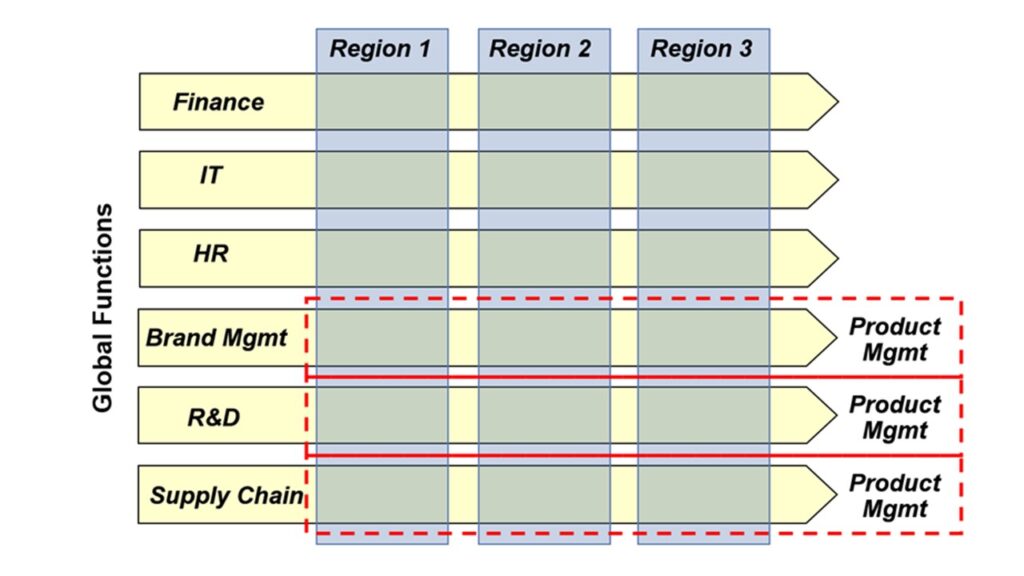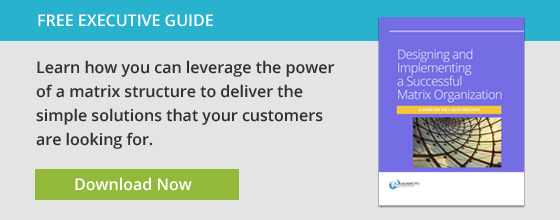November 30, 2016
When people talk about matrix organizations, different ideas come to mind. In the most straightforward sense, a matrix organization is when one individual formally reports to two or more managers (solid and dotted lines). We might also say that a matrix is one form (there are many) of organizational linking mechanisms that enable organizations to work across organizational boundaries. While many organizations have used a matrix structure with mixed success, the key to success is to mitigate the inherent risks of that type of organization.
When we talk about matrix organizations, we often talk about the dimensions of a matrix. We refer to dimensions as the different ways that an organization can choose to organize itself including function, geography, product, customer, process, or channel. There are others, but these are the most common dimensions that organizations typically use. Whenever an organization establishes a boundary (usually across two or more of these dimensions), we need a linking mechanism (such as a matrix structure) to help facilitate across the organizational boundaries.
In the illustration below, we have an example of a three-dimensional matrix organization comprised of function, region (geography), and product.
 In this three-dimensional matrix structure, we can see an R&D employee who has a functional R&D solid-line manager, a regional dotted line manager, and a product management reporting relationship all at the same time. While not uncommon, too often businesses struggle with how to design, operate, and implement the correct governance, performance management, resource allocation, role definitions, conflict resolution tactics, and reward systems to properly run and maximize a matrix. While frustrated business leaders often blame the matrix structure for performance challenges, the underlying issues affecting performance are more complex than the fact that the matrix is broken or ill-suited to the situation. There are other issues that make matrix organizations difficult to optimize.
The best way to mitigate the risks of an organization is to have a mechanism—a linkage that facilitates cross-boundary coordination and mitigates the organization dimension risks. As mentioned, a matrix structure is a form of linkage that like any organizational dimension has benefits and risks. The lists below detail some of the benefits and risks associated with a matrix organization:
Matrix Linkage Benefits:
In this three-dimensional matrix structure, we can see an R&D employee who has a functional R&D solid-line manager, a regional dotted line manager, and a product management reporting relationship all at the same time. While not uncommon, too often businesses struggle with how to design, operate, and implement the correct governance, performance management, resource allocation, role definitions, conflict resolution tactics, and reward systems to properly run and maximize a matrix. While frustrated business leaders often blame the matrix structure for performance challenges, the underlying issues affecting performance are more complex than the fact that the matrix is broken or ill-suited to the situation. There are other issues that make matrix organizations difficult to optimize.
The best way to mitigate the risks of an organization is to have a mechanism—a linkage that facilitates cross-boundary coordination and mitigates the organization dimension risks. As mentioned, a matrix structure is a form of linkage that like any organizational dimension has benefits and risks. The lists below detail some of the benefits and risks associated with a matrix organization:
Matrix Linkage Benefits:

 In this three-dimensional matrix structure, we can see an R&D employee who has a functional R&D solid-line manager, a regional dotted line manager, and a product management reporting relationship all at the same time. While not uncommon, too often businesses struggle with how to design, operate, and implement the correct governance, performance management, resource allocation, role definitions, conflict resolution tactics, and reward systems to properly run and maximize a matrix. While frustrated business leaders often blame the matrix structure for performance challenges, the underlying issues affecting performance are more complex than the fact that the matrix is broken or ill-suited to the situation. There are other issues that make matrix organizations difficult to optimize.
The best way to mitigate the risks of an organization is to have a mechanism—a linkage that facilitates cross-boundary coordination and mitigates the organization dimension risks. As mentioned, a matrix structure is a form of linkage that like any organizational dimension has benefits and risks. The lists below detail some of the benefits and risks associated with a matrix organization:
Matrix Linkage Benefits:
In this three-dimensional matrix structure, we can see an R&D employee who has a functional R&D solid-line manager, a regional dotted line manager, and a product management reporting relationship all at the same time. While not uncommon, too often businesses struggle with how to design, operate, and implement the correct governance, performance management, resource allocation, role definitions, conflict resolution tactics, and reward systems to properly run and maximize a matrix. While frustrated business leaders often blame the matrix structure for performance challenges, the underlying issues affecting performance are more complex than the fact that the matrix is broken or ill-suited to the situation. There are other issues that make matrix organizations difficult to optimize.
The best way to mitigate the risks of an organization is to have a mechanism—a linkage that facilitates cross-boundary coordination and mitigates the organization dimension risks. As mentioned, a matrix structure is a form of linkage that like any organizational dimension has benefits and risks. The lists below detail some of the benefits and risks associated with a matrix organization:
Matrix Linkage Benefits:
- Increased coordination across boundaries (boundary-less)
- Increased productivity through the sharing of resources
- Better insight into profits/costs
- Increased speed (to market speed)
- Smarter product design
- Increased time for performance management
- Increased confusion concerning decision making and authority
- Greater communication requirements (more meetings)
- Need for matrix management skills & professional attributes






